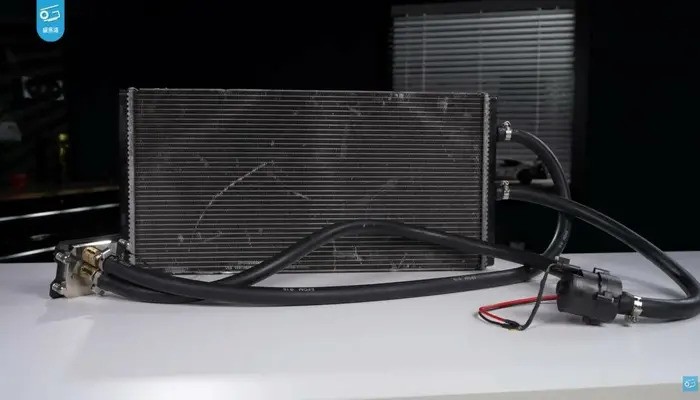In a bold experiment showcasing the extremes of Threadripper overclocking, a YouTuber managed to cool the ultra-powerful AMD Threadripper Pro 9995WX using a BMW M4 radiator. The goal? Push all 96 cores of this $11,700 processor to their absolute limits using an unconventional but massively powerful cooling system borrowed from a high-performance car.
Automotive Cooling Meets Desktop Power
YouTuber Geekerwan conducted the experiment during his in-depth review of AMD’s flagship workstation CPU. He equipped his setup with a 600x350mm radiator sourced from a BMW M4 and paired it with a high-flow pump. For context, this car radiator has around five times the surface area of a typical 360mm PC radiator, making it a serious piece of thermal hardware. The logic was simple: if the radiator could cool a 500-horsepower engine, it could surely tame a high-wattage CPU.
Read: Wi-Fi 8 Shifts Focus from Speed to Stability, Says Qualcomm
Pushing Core Performance
With the radiator and two powerful Toyota Highlander fans (each using 100W), Geekerwan pushed the 9995WX to 4,891 MHz across its 96 cores. The setup scored a massive 187,153 points in Cinebench R23—beating a previous record of 186,800 set by SkyWalkerAMD using a more conventional liquid cooling setup. Although this result still falls short of what liquid nitrogen cooling can achieve, it remains a remarkable feat for a practical and reusable configuration.
The Cooling Bottlenecks
Despite the radiator’s sheer size and the powerful fans used to move air across it, the system faced critical limitations. The most significant bottleneck was the CPU water block. While the radiator could dissipate large amounts of heat, the block simply couldn’t transfer it away from the chip quickly enough. The pump, rated for 1,200 liters per hour, also faced challenges pushing coolant through the complex network of pipes, tubes, and the restrictive water block.
This flow rate—although high on paper—dropped below 150 liters per hour due to resistance in the system. For comparison, a standard PC D5 liquid cooling pump is rated up to 1,500 L/h, but even those suffer from similar pressure losses in real-world builds.
Power Demands and Heat Output
Running the Threadripper Pro 9995WX under such stress drew staggering amounts of power. The HWinfo software reported brief spikes up to 2,000 watts using the SVI3 TFN metric, with more stable measurements—known as PPT (Package Power Tracking)—hovering around 1,251 watts. These numbers reflect how demanding modern high-core-count CPUs have become, especially when pushed far beyond stock performance levels.
Thermal readings showed the CPU’s 12 Core Complex Dies (CCDs) ranging from 66°C to 87°C during the test. However, it’s unclear how long the chip was kept under maximum load, so the temperature results may not fully reflect the sustained heat behavior under prolonged overclocking.
A Wild Yet Insightful Build
The experiment not only highlighted the cooling potential of non-traditional components but also revealed the thermal and architectural limits of even the most advanced CPUs. While the BMW radiator performed admirably in dissipating heat, the CPU’s own design—especially the density of heat generation in its dies and the limitations of available water blocks—remained the real hurdle.
Still, the benchmark result speaks volumes about the capabilities of AMD’s Threadripper Pro series. It also shows how extreme enthusiasts continue to challenge conventional limits with creativity, resourcefulness, and sometimes, automotive-grade parts.
When Creativity Meets Silicon
Ultimately, Geekerwan’s setup demonstrated how creative engineering can stretch the capabilities of even the most demanding hardware. While this cooling solution may not be practical for everyday users, it underlines the growing need for high-performance cooling solutions as workstation CPUs continue to pack in more cores and push higher wattages.
The mix of car parts and cutting-edge computing may sound strange—but it’s exactly the kind of innovation that drives hardware testing forward.
Follow us on Instagram, YouTube, Facebook,, X and TikTok for latest updates
